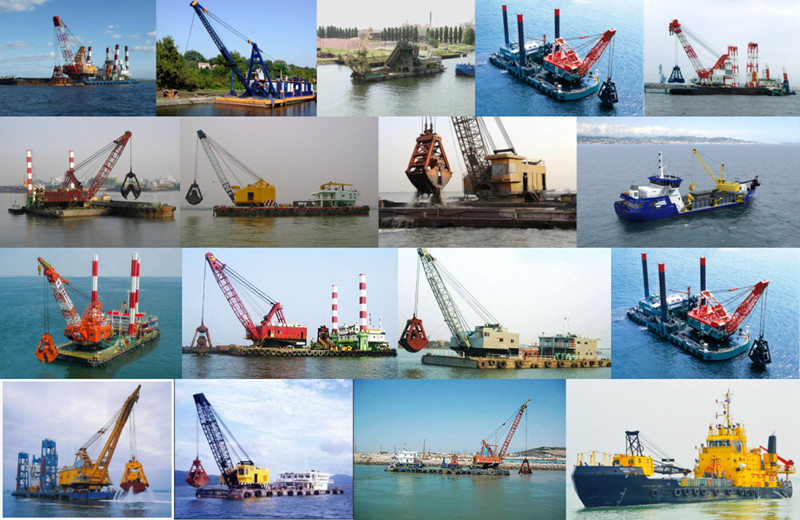Grab Dredger is self-propelled and non self propelled two. Self propelled generally hopper belt, mud tank filled from airlines to mud area dumping; non self propelled by mud Barge clay loading and unloading mud: use of wire rope Grab Dredger, relying on the action of gravity, into the water to a certain depth, by the insertion of a mud layer and a closed grab to mining and grab sediment, then through the manipulation of ship crane mechanical lifting grab out of the water, swing to a predetermined position the sediment discharge into the hopper or mud barge, and so forth. Grab dredger for waterway and harbor pool, and water infrastructure dredging work. Suitable for mining silt, gravel and clay, but it is not suitable for mining sand and silt.
Photo of our Grab Dredger:
principle
Dredging using wire rope grab, rely on the action of gravity, into the water to a certain depth, by the insertion of a mud layer and a closed grab to mining and grab sediment, then through the manipulation of ship crane mechanical lifting grab out of the water, swing to a predetermined position the sediment discharge into the hopper or mud barge, and so forth.
classification
Grab dredger is self-propelled and non self propelled two. In general, the tank is filled with mud, and the mud tank is filled with dump mud from the air to the dump area.
Key points of construction technology control
Transverse excavation method construction
Grab dredger for horizontal excavation. Operation timed assigns 5 mooring, main anchor cable length should be 200 to 300 meters, the anchor tail length should be 200 to 300 meters, high velocity of poor quality long timely. The edge should be thrown in mooring line outside the 100 meters. Near point positioning, anchored procedures and chain bucket ship basically the same.
The concurrent and countercurrent construction
Grab dredger should adopt concurrent construction. When the flow rate is not large or there is a reciprocating flow, it can be used as a counter current.
Grab Dredger Bucket Chain Dredger,Bucket Ladder Dredger,Cutter Suction Dredger,Backhoe Dredger Unisite Group Ltd. , http://www.unisitemarine.com
Hand-held chlorophyll meter is a hand-held spectrometer that uses two different wavelengths of light to illuminate the surface of plant leaves. The SPAD value is obtained by comparing the optical density of the transmitted light passing through the leaves. The leaf chlorophyll content can be non-destructively tested in the field. . Due to its characteristics of being fast, convenient, and not damaging to the measurement object, it has been widely used in agricultural production since the 1990s. For this purpose, the chlorophyll content in the leaves of Camellia oleifera seedlings was determined using a handheld chlorophyll meter, and the distribution of chlorophyll content in different parts of leaves and leaves of different varieties was elucidated, in order to provide a basis for the rapid identification of Camellia oleifera seedlings.
Camellia oleifera seedlings were planted in a large plastic bag filled with cocoon fertilizer and humus in the nursery's inner high X15Qu and 35 Dimensional diameter. The Camellia oleifera varieties were Changlin 03}oD3, Changlin Od}oDa), Changlin 23(c}3) and Changlin}10(ch0), both of which were introduced in Hainan. Take 20 tea plants of the same age and height similar to 4 varieties as research objects. Using the handheld chlorophyll meter, 3 different parts of the unfolded leaves of three different positions (central, middle, and lower) of each strain were measured. Each point was measured 3 times and averaged. value. The average value of the sum of the measured values ​​at the three different parts of the expanded leaf represents the chlorophyll content of the leaf at the location of the plant.
Through the handheld chlorophyll meter, the chlorophyll content was closely related to the photosynthesis of Camellia oleifera. The content of chlorophyll was closely related to the photosynthesis of Camellia oleifera. The content of chlorophyll was high, the physiological activity of the leaves was high, photosynthesis was promoted, and the content of chlorophyll was caused by leaf senescence and photosynthesis. With it decreased. Different varieties of Camellia oleifera seedling leaves have different SPAD values, and the use of leaf SPAD values ​​to evaluate the adaptability of Camellia oleifera seedlings needs to vary from cultivar to cultivar. The SPAD value of middle leaves in the middle leaves of Camellia oleifera seedlings was not highly variable and relatively stable. Therefore, from the analysis of representativeness, the SPAD value of this part was better.

Analysis of health status of Camellia oleifera leaves with handheld chlorophyll meter
As a woody oil crop, Camellia oleifera has a long history of planting and has a large area for cultivation, and its uses are also numerous. For field crops, some symptoms can be seen by the naked eye in the absence of certain elements. For example, crops lack nitrogen and old leaves lose green. Therefore, to timely and quickly evaluate the adaptability of crops, we can observe the color change of the leaves. For instruments for determining leaf chlorophyll content, handheld chlorophyll meters manufactured by Top Instrument Co., Ltd. are recommended.